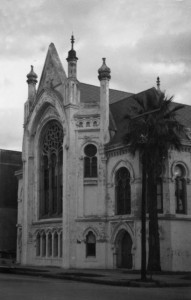Rabbi Henry Cohen
Values Codes I – H – E – L – P
“The First Citizen of Texas.” — Woodrow Wilson
“The Prime Minister of American Jewry.” — Rabbi Stephen S. Wise
Henry Cohen was born in London in 1863, the youngest of seven children of Josephine and David Cohen, themselves immigrants from Poland.
At fifteen years of age he obtained a full-time job with the Board of Guardians for the Relief of the Jewish Poor, working as an “almoner”–a distributor of charitable gifts.
Henry Cohen attended Jews’ College and graduated as a “Minister,” prepared to serve as a Torah reader, Hebrew teacher, schochet (ritual slaughterer), and mohel (ritual circumciser).
Along the way . . .
After graduation, Henry and his brother, Mark Cohen, traveled to Cape Town, South Africa.
There, Henry Cohen acted as an interpreter for the government.
His first pulpit was at the Kingston Synagogue in Jamaica.
In 1885, he accepted a position as rabbi of Congregation Beth Israel in Woodville, Mississippi, near Natchez.
Galveston
In 1888, Henry Cohen accepted the pulpit of Congregation B’nai Israel in Galveston, Texas.
According to reports, Cohen was a poor preacher because he stammered with his English accent. The congregation concluded that, “either he would get over it, or they would just have to get used to it.”
Rabbi Cohen was of short stature, of quick movements, and of spry gait. He wore white bow ties and starched cuffs, on which he would make notes of things he had to do.
He created a large library and was a collector of Jewish music.
Congregation B’nai Israel was a Reform synagogue. Rabbi Cohen intermixed both Sephardic and Ashkenazi readings and melodies.
Civic
Rabbi Cohen served on Galveston’s Board of Education and the Community Forum.
He declined the presidency of many other civic organizations.
Cohen was deeply involved with prison reform, helping to re-settle released inmates.
Community
In 1900 a hurricane and tidal wave swept over Galveston Island, taking the lives of 6,500 people. Over 3,000 homes and business were destroyed. 49 Jews were lost as well and many Jewish homes and businesses.
Congregation B’nai Israel, which sustained only minor damage, was one of the few houses of worship that survived.
On Sundays, Rabbi Cohen opened the doors of his synagogue to Christians whose churches had been destroyed.
After two more storms hit Galveston in 1910 and 1915, the population began to shrink and businesses moved away to safer places.
Rabbi Cohen chose to stay and continue to be a leader to both his congregation and the community as a whole.
Rabbi Cohen helped implement the Galveston Plan with the help of Jacob Schiff, the American Jewish financier. The plan brought ten thousand Jewish immigrants into America by way of Galveston, avoiding the crowded conditions of New York’s East Side.
Most of these immigrants were sent Northward and Westward to cities and towns that needed their skills.
Family
Rabbi Henry Cohen married Mollie Levy, a native of Texas, in 1889. She worked by his side, visiting the sick and performing other tasks.
They had two children, Ruth and Harry.
Rabbi Henry Cohen passed away in 1952.
Sources
- Marguerite Meyer Marks, “Rabbi Henry Cohen: Memories of Rabbi Henry Cohen As I Knew Him,” Western States Jewish History 18/2.
- David B. Albert, “Rabbi Henry Cohen: Rabbi Henry Cohen of Galveston, a 1931 Account,” Western States Jewish History 26/4.
- Hollace Ava Weiner, Jewish Stars in Texas: Rabbis and their Work (College Station: Texas A&M University Press, 1999).

